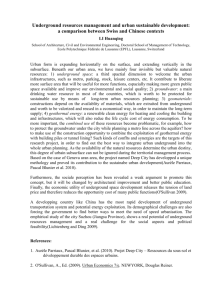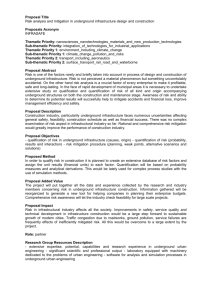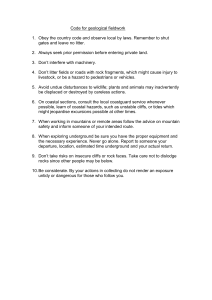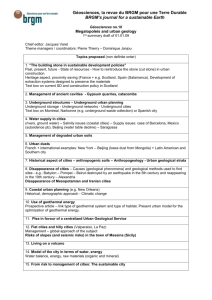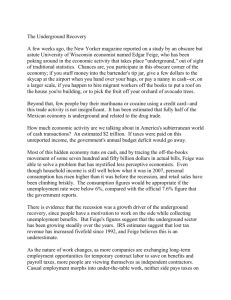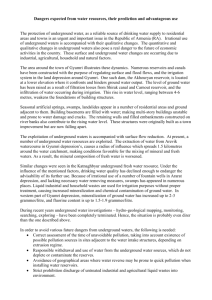Informal and Underground Economy
advertisement
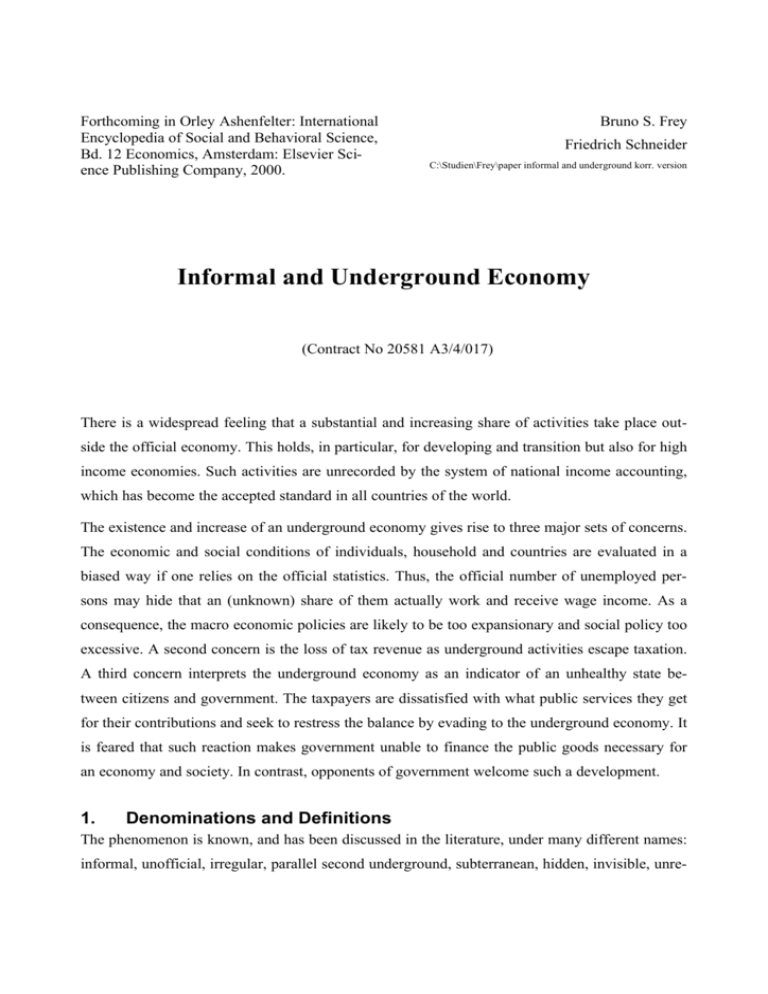
Forthcoming in Orley Ashenfelter: International Encyclopedia of Social and Behavioral Science, Bd. 12 Economics, Amsterdam: Elsevier Science Publishing Company, 2000. Bruno S. Frey Friedrich Schneider C:\Studien\Frey\paper informal and underground korr. version Informal and Underground Economy (Contract No 20581 A3/4/017) There is a widespread feeling that a substantial and increasing share of activities take place outside the official economy. This holds, in particular, for developing and transition but also for high income economies. Such activities are unrecorded by the system of national income accounting, which has become the accepted standard in all countries of the world. The existence and increase of an underground economy gives rise to three major sets of concerns. The economic and social conditions of individuals, household and countries are evaluated in a biased way if one relies on the official statistics. Thus, the official number of unemployed persons may hide that an (unknown) share of them actually work and receive wage income. As a consequence, the macro economic policies are likely to be too expansionary and social policy too excessive. A second concern is the loss of tax revenue as underground activities escape taxation. A third concern interprets the underground economy as an indicator of an unhealthy state between citizens and government. The taxpayers are dissatisfied with what public services they get for their contributions and seek to restress the balance by evading to the underground economy. It is feared that such reaction makes government unable to finance the public goods necessary for an economy and society. In contrast, opponents of government welcome such a development. 1. Denominations and Definitions The phenomenon is known, and has been discussed in the literature, under many different names: informal, unofficial, irregular, parallel second underground, subterranean, hidden, invisible, unre- 2 corded and shadow economy or moonlighting. In several languages the term most often used is black economy (le travail au noir, Schwarzarbeit, svarta sektor). No single definition exists but it depends on the purpose. The most precise and predominantly used definition seeks to relate the underground economy to officially measured national income: It comprises all presently not recorded productive (i.e. value-adding) activities which should be in the national product (GNP). This definition allows to compare and to add the underground economy to GNP. This definition excludes two major activities: (a) Production that by convention is not part of GNP, in particular private household activities. The evaluation of its size has gendered a research area of its own. Depending on the approach and measurement technique, the household sector comprises between 30% and 50% of GNP. (b) Tax evasion is not value adding but redistributional and is therefore not included as such in the above definition (e.g. when taxes on interest payments are evaded). However, in general, no taxes are paid on underground activities (such as moonlighting for house building) which are value-adding. Thus, underground activities and tax evasion are related but certainly not identical. Tax evasion has also become a research area of its own. For the United States between 1973 and 1992 for example, it has been estimated that 17% of the taxes owned have been evaded. The underground economy should neither be identified with illegality. Some activities are perfectly legal but are not subject to taxes (e.g. because of their small size), and therefore escape measurement in official statistics. Other activities are legal as such, but taxes are evaded. Finally, on illegal activities (such as drug production and distribution) no taxes are paid. Broader definitions of the informal and underground economy, depending on their purpose, include private household production and redistributional activities. In the following, the more narrow definition considering on unrecorded productive activities will be focussed on. 2. Measurement approaches The major emphasis of economists has been to measure the size of the underground economy relative to official GNP; its size compared to other countries and its development over time. The other social sciences, especially sociology, have put more emphasis on the structure: who partici- 3 pates where? The respective studies often provide highly detailed analyses of particular regions, industries and types of underground activities. In the 1980s and 90s, the quest to measure the size of the underground economy has led to interesting methodological innovations, i.e. the challenge to “measure the invisible” has resulted in new measurement methods. Three general sets of measurement approaches may be distinguished: 2.1 Direct approaches An obvious way to analyze the underground economy is to undertake surveys among (supposed) suppliers and demanders of such services. This method allows to gather a detailed picture of the structure of this sector. However, because a substantial part of these activities is illegal, the interviewees may not be prepared to disclose their involvement. Somewhat surprisingly, research has shown this is no serious problem. Typically, men are more involved than women, the young more than the old, people without work more than employed ones, and the most prominent sectors are construction and all kinds of services. In contrast, where substantial capital assets (which are visible) are needed, less underground activity is observed. A second direct approach is based on auditing of tax returns undertaken by tax collection and social security administrations. A sample of tax payers is scrutinized in depth and under threats of sanctions for failing collaboration. This approach provides detailed information on the strongest evaders, in particular the self-employed who have better opportunities for concealment. Capital income lends also easier to evasion than labor income. Tax audits have proved unable to reveal all tax evasion, and are limited to taxable activities. As a large part of tax evasion is redistributional, that part is not relevant to the narrow definition of the underground economy. A disadvantage of the two direct methods (surveys and tax auditing) is that they lead only to point estimates. Moreover, it is unlikely that they capture all „shadow“ activities, so they can be seen as providing lower bound estimates. They are unable (at least at present) to provide estimates of the development and growth of the shadow economy over a long period of time. They have, however at least one considerable advantage - they can provide detailed information about shadow economy activities and the structure and composition of those who work in the shadow economy. 4 2.2 Indirect or Discrepancy approaches The underground economy is reflected in discrepancies showing in various markets. Persons working in the unofficial sector are able to spend more than their officially recorded income. The discrepancy between the two may be observed at the level of individual households as well as in the aggregate national accounts. This approach is questionable as this expenditureincome discrepancy may either be due to measurement errors (which is indeed often the case) or to reasons unrelated with the underground economy (e.g. the use of credits or reductions in wealth). Another discrepancy may be observable in the labor market. A decline in official participation rates, or a low participation rate compared to other countries, may be an indication of unofficial work. But again, the discrepancy may be related to other factors. Moreover, this approach is unable to isolate those persons who are at the same time active in the official and the unofficial economy (which is often the case). A third discrepancy may be visible in the monetary market. The dominant approach starts from the assumption that underground transactions are paid in cash in order to make detection more unlikely. The size of the underground economy is reflected in the amount of cash used in a country beyond that used for official transactions. This approach is elegant and easily applicable because the amount of currency is well documented. The assumption that unofficial activities are transacted in cash is, however, questionable. Empirical research suggests that between 20% and 30% of the unofficial activities are not paid in cash, i.e. either by payment in kind or via a bank. This fact is especially bothersome for the currency demand approach when the share of cash payments changes over time and differs between countries. A significant portion of some currencies is held outside the country issuing it; thus the US dollar is widely used in South America and Asia. Again, the discrepancy is influenced by many factors unrelated to the underground economy such as the use of credit cards. Finally, it is problematic to infer the size of the unofficial sector from currency transactions because the velocity of cash circulation may differ between the official and the unofficial sector. Some of the difficulties just mentioned have been successfully addressed by more recent research.1) In particular, instead of comparing the actual use of cash to the one deemed necessary for the official economy, a cash demand function is empirically meas1) The use of credit cards and the amount of currencies outside a country have been taken into account in some studies, compare e.g. Schneider (1994) and Rogoff (1998). 5 ured i.e. econometrically estimated. This allows to control for influences (such as changes in the rate of interest or the increasing us of substitutes for cash) unrelated to the underground economy. Moreover, the extra use of cash has been directly attributed to causal factors, most importantly to an increase in the tax and social security burden. Figures for the size and development of the shadow economy can be calculated by comparing the difference between the development of currency when the direct and indirect tax burden and government regulations are held at its lowest value, and the development of currency with the current (much higher) burden of taxation and government regulations. The currency demand approach is one of the most commonly used approaches. It has been applied to 17 OECD countries. The latest developed discrepancy approach looks at physical inputs, in particular the use of electricity. It is calculated how much electricity would normally be used to produce the official national income. The excess use can be attributed to the underground economy. This approach has again the great advantage of relying on easily available data, which is a distinct advantage for developing and transition economies. However, not all underground activities use much or even any electricity, and the relationship between production and electricity used may change over time, or differ between countries, due to substitution and technical progress. A general problem of all discrepancy approaches is that one has to assume a base year without underground economy. Only then it is possible to attribute the existence and rise of a discrepancy to the underground economy. 2.3 The Model approach This method focuses on the causes and effects of the underground economy. By constructing a model, it seeks to identify the unobserved sector in-between. Three sets of factors are taken to be the main motivators of whether to engage in the unofficial economy: (i) Incentives to exit the official economy are the burden of taxation and of social security contributions, as well as government regulations. The latter hinder or even prohibit activities in the official economy (e.g. because of a lack in work permit, especially for foreigners) which provides an incentive to undertake them unofficially. This holds, of course, also for illegal activities such as the production and distribution of drugs. An important reason to exit the official sector are the restrictions imposed on working time. Low work 6 hours, long holidays, early retirement, and above all unemployment are important reasons for moonlighting. (ii) Disincentives to be active in the underground economy are the expected punishment of doing so. It is composed of the probability to be caught and the size of punishment. For persons outside the established society (for example for illegal immigrants), or being selfemployed, expected punishment is lower than for other persons, and therefore a higher rate of participation in the underground sector is likely. (iii) Another disincentive to be active in the underground economy is the moral costs entailed. A good citizen has moral qualms to undertake a forbidden activity. These moral costs are closely related to “tax morale” which motivates citizens to pay their dues to the state. The effects of the underground economy are reflected in the traces visible in the labor, money and product markets discussed above. A specific econometric technique called “unobservable variables” allows to estimate the size of the underground economy lying between the causes and effects. This approach is the most comprehensive and builds on a well-structured behavioral model but it requires a large amount of data. As these are often not available (in particular not for developing and transition economies) this approach is not generally applicable. The estimation technique moreover tends not to be statistically robust (i.e. small changes in specification and values of variables strongly affects the estimates). 3. Empirical estimates The following tables serve to indicate approximate magnitudes of the size and development of the underground economy, defined as productive activities, i.e. using the narrow definition. Table 1 prevents a rough comparison of the size of the underground economies relative to GNP for a selection of Western European countries, Japan and the United States for the mid 1990s, using the currency demand approach. _______ Table 1 _______ The South European countries (Greece, Italy) have an underground economy almost one third as large as the officially measured GNP: followed by Spain, Portugal and Belgium having a shadow economy between 20-24 % (of official) GNP. According to these estimates, the Scandinavian 7 countries also have a sizeable unofficial economy (between 18-20 % of GNP), which is attributed mainly to the high fiscal burden. The “central” European countries (Ireland, the Netherlands, France, Germany and Great Britain) have a smaller underground economy (between 13-16 % of GNP) probably due to a lower fiscal burden and moderate regulatory restrictions. The lower underground economies are estimated to exist in countries with relatively low public sectors (Japan, the United States and Switzerland), and comparatively high tax morale (United States, Switzerland). Table 2 provides a rough comparison of the size of the underground economy relative to official GNP for a selection of developing and transition economies for the beginning of the 1990s, using the physical input (electricity) demand approach. Some of these countries (Nigeria, Egypt, Thailand) are estimated to have an underground sector nearly three quarters the size of officially recorded GNP. In many countries the size is one quarter to one third of GNP. In Asian countries with a comparatively low public sector, high tax morale or high expected punishment (Hong Kong, Singapore) the underground economy is estimated to be similar to that in many “northern” European countries. _______ Table 2 _______ Transition economies are estimated to often have substantial unofficial activities, many around one quarter of GNP. An exception is ex-Czechoslovakia where according to these estimates the underground sector is clearly around ten percent of GNP. Table 3 reports estimates of the growth of the underground economy (relative to GNP) for selected Western countries and the United States, using the currency demand approach. _______ Table 3 _______ The Scandinavian (Sweden, Norway, Denmark) and the German speaking countries (Germany, Austria) exhibit a sizeable increase of the underground economy within the 35 years (1960-1995) covered. But also the countries with a low share in the beginning (Switzerland, the United States) show a significant increase, for the U.S. the share more than doubled. Sizeable increases have been estimated, with few exceptions, for all types of countries and all kinds of approaches: the 8 increasing importance of the underground relative to the official economy is a robust phenomenon. 4. The Effects of the Shadow Economy on the Official Economy In order to study the effects of the shadow economy on the official one, several authors integrate underground economies into macro economic models2); these researchers develop a macro model of the business cycle as well as tax and monetary policy linkages with the shadow economy. They conclude from their investigation of the growth of the shadow economy that on the one side its effect should be taken into account in setting tax and regulatory policies and one the other side that the presence of a shadow economy could lead to an overstatement (understatement) of the inflationary (unemployment) effects of fiscal or monetary stimulus. Adam and Ginsburgh (1985) focus on the implications of the shadow economy on "official" growth in their study for Belgium. They find a positive relationship between the growth of the shadow economy and the "official" one and under certain assumptions (i.e. very low entry costs into the shadow economy due to a low probability of enforcement) they conclude that an expansionary fiscal policy has a positive stimulus for both the formal and informal economies. A study for the United States argues that the U. S. productivity slowdown over the period 1970 to 1989 was vastly overstated, as the underreporting of income due to the more rapid growth of the U. S. shadow economy during this period was not taken into account. The underground economy can be beneficiary in that sense that it responds to the economic environment's demand for urban services and small-scale manufacturing. From this point of view the informal sector provides the economy with dynamic and entrepreneurial spirit and can lead to more competition, higher efficiency and strong boundaries and limits for government activities. The informal sector may offer contributions to the creation of markets, increase financial resources, enhance entrepreneurship, and transform the legal, social, and economic institutions necessary for accumulation. The voluntary self-selection between formal and informal sector, as described above, may provide a higher potential for economic growth and, hence, a positive correlation between an increase of the informal sector and economic growth. Also some more additional positive „side effects“ of shadow economy activities must be considered: Empirical find- 2) For Austria this was done by Schneider, Hofreither, and Neck (1989), for Belgium by Adam and Ginsburgh (1985) and for the U.S. by Fichtenbaum (1989). 9 ings of Schneider (1999) show clearly that over 66 % of the earnings in the shadow economy are rather immediately spent in the official sector in Germany and Austria and provide a considerable boost for the official economy; hence the positive effects of these expenditures for economic growth and for (mostly indirect) tax revenues must be taken into account as well. Evidence for the U.K. shows that the hidden economy has a significant stimulative effect on the consumer expenditure. 5. Policy Consequences The growth of the underground economy over the last decades and its effect on the official economy both in general perception and scholarly research has prevailingly been evaluated as a negative development which should be counteracted. In particular, politicians and public officials have pointed out that the state’s capacity to provide the desired public services is undermined. But not all commentators share this view. Some see it as a welcome and effective limit on governments’ tendency to continually raise the fiscal burden, and to impose more and more restrictions on the economy and society. It has also been argued that many developing and transition economies would break down or function at a much lower level of production and welfare if the underground economy did not exist. As has just been argued in section 4, too, unofficial activities are seen as a desirable addition to the official economy whose productivity is strongly reduced by excessive taxation and bureaucratic restrictions. A less pronounced evaluation points out that the rise of the underground economy indicates that the relationship between the state and the citizens is fragile and needs improvement. The fight against the underground economy is a recurrent theme in many countries. The dominant method is to increase deterrence. The probability of being caught is raised by more regular and intensive controls, often by the police. Punishment is raised by imposing higher fines and, in severe cases, prison sentences. The target are both buyers and suppliers of goods and services produced in the underground sector. The success of such deterrence policies is rather uncertain. In the case of the underground sector related to drug, prostitution and alcohol prohibition the effect has turned out to be at best weak, if not counterproductive. Many persons active in the underground economy move more deeply into illegality in order to make detection more difficult. As a result, the underground activities become 10 more criminalized, and more difficult to observe and to influence. Well organized and ruthless organized crime (often called the Mafia) becomes more dominant. A deterrence policy needs not always be a failure but the successes tend to be short run. Provided the demand for underground goods and services remains intact, the profit opportunities in the underground economy become so large that supply reappears and the underground economy recouperates. A less oppressive policy is to lure people into the official economy by legalizing parts of the underground economy, and by facilitating the more into the official economy (e.g. by granting an amnesty). Such measures have proved to be only moderately successful. A positive approach to raise the motivation to stay in the official economy by improving the efficiency of public services, reducing the tax and social security burden imposed on labor and/or by raising civic virtue has been used only rarely. Many policy makers doubt whether such measures work at all. In any case, they are effective only in the longer run. One possibility is to adjust public supply more closely to what the citizens desire, and to lower cost for a given quantity and quality of public supply. This can be attempted by streamlining public sector activities (e.g. by New Public Management). A more fundamental way is to improve the political process via opening the political arena to contending interests, and strengthening the democratic participation rights of the citizens. Bruno S. Frey University of Zurich and Friedrich Schneider University of Linz 11 Bibliography Adam, M.C. and Ginsburgh, V. (1985). The effects of irregular markets on macroeconomic policy: Some estimates for Belgium, European Economic Review, 29/1 (March), pp.15-33. Andreoni, J.; B. Erard and J. Feinstein (1998). Tax Compliance. Journal of Economic Literature 36: 818-860. Cowell, Frank A. (1990). Cheating the Goverment. The Economics of Evasion. Cambridge, M.A.: MIT Press. De Soto, Hernando (1989). The Other Path: The Invisible Revolution in the Third World. New York: Harper and Row. Feige, Edgar L. (ed.) (1989). The Underground Economies. Tax Evasion and Information Distortion. Cambridge: Cambridge University Press. Fichtenbaum, R. (1989). The productivity slowdown and the underground economy, Quarterly Journal of Business and Economics, 28/3 (September), pp.78-90. Frey, Bruno S. and Werner W. Pommerehne (1984). The Hidden Economy: State and Prospect for Measurement. Review of Income and Wealth 30 (march): 1-23. Gaertner, W. and A. Wenig (eds) (1985). The Economics of the Shadow Economy. Berlin: Springer. Mars, G. (1994). Cheats at Work. An Anthropology of Workplace Crime. Brookfield: Dartmouth Publ Co. Pozo, S. (ed.) (1996). Exploring the Underground Economy: Studies of Illegal and Unreported Activity. Kalamazaro: Upjohn. Pyle, D. J. (1990). The Informal Economy. Utrecht. Rogoff, K. (1998). Blessing or Curse? Foreign and underground demand for the euro notes, Economic policy: The European Forum 26 (July), pp.261-304. Schneider, F. (1999). Der Sozialstaat zwischen Markt und Hedeonismus?, in: Lamnek, S. und Luedtke, J. (Hrsg.), Otto-von-Freising-Tagungen der Katholischen Universität Eichstätt, Leske + Budrich, Opladen 1999. 12 Schneider, F. and Enste, D. (1998). Increasing Shadow Economics All Over the World - Fiction or Reality? Working Paper 9819, Institute of Economics, University of Linz. Schneider, F. (1994). Can the shadow economy be reduced through major tax reforms? An empirical investigation for Austria, Supplement to Public Finance/Finances Publiques, 49 (March), pp.137.152. Schneider, F., Hofreither, M.F. and Neck, R. (1989). The consequences of a changing shadow economy for the official economy: Some empirical results for Austria, in: Boes, D. and Felderer, B. (eds.), The political economy of progressive taxation, Heidelberg: Springer publishing company, pp.181-211. Simon, C. P. and A. D. Witte (1982). Beating the System - The Underground Economy. Boston: Auburn House. Tanzi, V. (ed.) (1982). The Underground Economy in the United States and Abroad. Lexington: Lexington Books. Thomas, James J. (1992). Informal Economic Activity. London: Wheatsheaf. United Nations (1993). Inventory of National Practices in Estimating Hidden and Informal Economic Activities for National Accounts. Geneva: United Nations. Weck-Hannemann, Hannelore; Werner W. Pommerehne and Bruno S. Frey (1984). Schattenwirtschaft. München: Vahlen. 13 Table 1: Size of the underground economy relative to GNP in various European countries, mid 1990s. Estimation based on the currency demand approach. Greece Italy Spain Portugal Belgium Sweden Norway Denmark Ireland France Netherlands Germany Great Britain Japan United States Austria Switzerland 27-30% 20-24 % 18-23% 13-16% 8-10% Source: Compiled from Schneider and Enste (1998). 14 Table 2: Size of the underground economy relative to GNP in various developing and transition countries, beginning of the 1990s. Estimates based on the physical input (electricity) demand approach. Developing Countries Africa Nigeria Egypt Tunisia Morocco 68-76% 39-45% Central and South America Guatemala Mexico Peru Panama Chile Costa Rica Venezuela Brazil Paraguay Columbia 40-60% 25-35% Asia Thailand Philippines Sri Lanka Malaysia South Korea Hong Kong Singapore 70% 38-50% 13% 15 Transition Economies Central Europe Hungary Bulgaria Poland Rumania Slovakia Czech Republic 24-28 % 16-20 % 7-11 % Former Soviet Union Countries Georgia Azerbaijan Ukraine Belarus Russia Lithunia Latvia Estonia 28-43 % 20-27 % Source: Compiled from Schneider and Enste (1998). 16 Table 3: Growth of the underground economy relative to GNP for selected West European countries and the United States, 1960-1995. Estimates based on the currency demand approach (rounded figures). 1960 1995 Percentage point increase Sweden 2% 16% 16,5% Denmark 4,5% 17,5% 13,0% Norway 1,5% 18,0% 16,5% Germany 2% 13,2% 11,2% United States 3,5% 9,5% 6% Austria 0,5% 7% 6,5% Switzerland 1% 6,7% 5,7% Source: Compiled from Schneider and Enste (1998).
